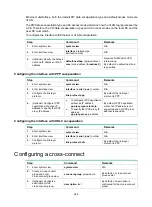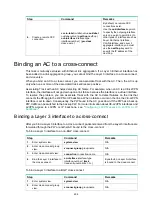
391
Remote connection establishment
To set up a remote MPLS L2VPN connection:
1.
Set up a public tunnel to carry one or more PWs between PEs:
The public tunnel can be an LSP, MPLS TE, or GRE tunnel.
If multiple public tunnels exist between two PEs, you can configure a tunnel policy to control
tunnel selection. For more information about tunnel policies, see "Configuring tunnel policies."
If a PW is established over an LSP or MPLS TE tunnel, packets on the PW have two labels. The
outer label is the public LSP or MPLS TE tunnel label that MPLS uses to forward the packet to
the peer PE. The inner label is the PW label that the peer PE uses to forward the packet to the
destination CE.
2.
Set up a PW to connect customer networks:
PWs include static PWs, LDP PWs, BGP PWs, and Circuit Cross Connect (CCC) PWs.
To establish a static PW, configure the peer PE address, and the incoming and outgoing PW
labels for the PW on the two PEs. Static PWs consume a small amount of resources but have
complex configurations.
To establish an LDP PW, configure LDP and specify the peer PE address on the two PEs. LDP
defines a new FEC type named PW ID FEC for PEs to exchange PW-label bindings. The new
FEC type uses a PW ID and a PW data encapsulation type to identify a PW. The PW ID is the ID
of the PW between PEs. The PW data encapsulation type specifies the encapsulation type for
data transmitted over the PW, such as FR, Ethernet, or VLAN. PEs advertise the PW label and
PW ID FEC in label mapping messages to create a PW. Dynamic PWs have simple
configurations but consume more resources than static PWs.
To establish BGP PWs, BGP advertises label block information in an extended BGP update to
PEs in the same VPN. Each PE uses the received label block information to calculate outgoing
labels and uses its own label block to calculate incoming labels. After two PEs complete label
calculation, a BGP PW is established between them. BGP PWs have the following features:
{
Simplified configuration
—There is no need to manually specify peer PEs. A PE
automatically find peer PEs after receiving label block information from the peer PEs.
{
Reduced workload
—Label block advertisement enables assigning labels for multiple PWs
at one time.
To establish a CCC PW, manually specify the incoming and outgoing labels for the PW on the
PEs, and create two static LSPs in opposite directions on P devices between PEs. There is no
need to configure a public tunnel for the CCC PW. CCC employs only one level of label to
transfer packets. The static LSPs on the P devices transfer data only for the CCC PW. They
cannot be used by other connections or MPLS L3VPN.
3.
Set up an AC between a PE and a CE:
Set up an AC by configuring a link layer connection (such as a PPP connection) between a PE
and a CE.
An AC can be one of the following types:
{
Layer 3 physical interface or Layer 3 virtual interface
—Transparently forwards received
packets over the bound PW. The interface can be an Ethernet interface or an FR interface.
{
Layer 3 subinterface
—Forwards packets received from the corresponding link (such as
VLAN or FR DLCI) to the bound PW. In this mode, VLANs are unique on a per interface
basis rather than on a global basis.
NOTE:
When VLANs are globally unique, packets with the same VLAN ID are forwarded over the PW
bound with that VLAN ID regardless of the receiving interfaces. If VLANs are unique on a per
interface basis, packets with the same VLAN ID from different interfaces can be forwarded over
different PWs.
















































